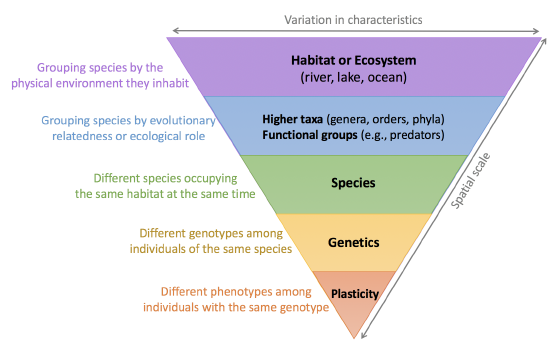5: Functional Diversity - Stress and Enemies
- Page ID
- 62276
 Scientists have estimated that there are ~8.7 million species on Earth. How does one planet support such enormous diversity of species? The answer relates to the impressive functional diversity (Fig 5.0.1) that organisms display – that is, the diversity in strategies and adaptations that different organisms have for surviving in their environment. The functional diversity sections address different strategies and adaptations for acquiring nutrients and resources from the environment, dealing with stressful environmental conditions (ex. heat stress), succeeding at or defending against predation, and successfully completing the life cycle.
Scientists have estimated that there are ~8.7 million species on Earth. How does one planet support such enormous diversity of species? The answer relates to the impressive functional diversity (Fig 5.0.1) that organisms display – that is, the diversity in strategies and adaptations that different organisms have for surviving in their environment. The functional diversity sections address different strategies and adaptations for acquiring nutrients and resources from the environment, dealing with stressful environmental conditions (ex. heat stress), succeeding at or defending against predation, and successfully completing the life cycle.
This second chapter will focus on strategies organisms use to deal with abiotic stressors (such as thermal stress) and biotic stressors (such as predation and parasitism) and how abiotic and biotic interactions shape an organism's niche.
Figure \(\PageIndex{1}\): Schematic of the magnitude and type of diversity exhibited at different scales. This section focuses on functional group diversity. Figure by L Gerhart-Barley.
- 5.1: The Ecological Niche
- An important concept in ecology, which will be discussed in several contexts throughout the quarter is the ecological niche. A species’ ecological niche is the abiotic and biotic conditions the species requires in order to grow, reproduce, and survive. Every species, therefore, has a fundamental niche, which are the abiotic conditions the species can physiologically tolerate, as well as a realized niche, which is driven by species interactions.
- 5.2: Acclimation and Adaptation
- Species respond to environmental stressors through acclimation and adaptation. Acclimation occurs when an individual organism experiences a change in its phenotype in response to an environmental stressor. This change is reversible and occurs very rapidly, sometimes in as little as a few minutes. Adaptation occurs when a population experiences a change in its genotype in response to an environmental stressor. This change occurs much more slowly, usually across many generations, and is a result o
- 5.3: Stress - Thermoregulation
- Thermoregulation (managing body temperature) is a critical consideration for all organisms due to the impact that changing temperatures have on biochemical structures and processes.
- 5.4: Enemies - Predation
- At its simplest, we can consider predation (or herbivory) to be a function of predators (or herbivores) detecting, capturing, and consuming prey (or plant) individuals


